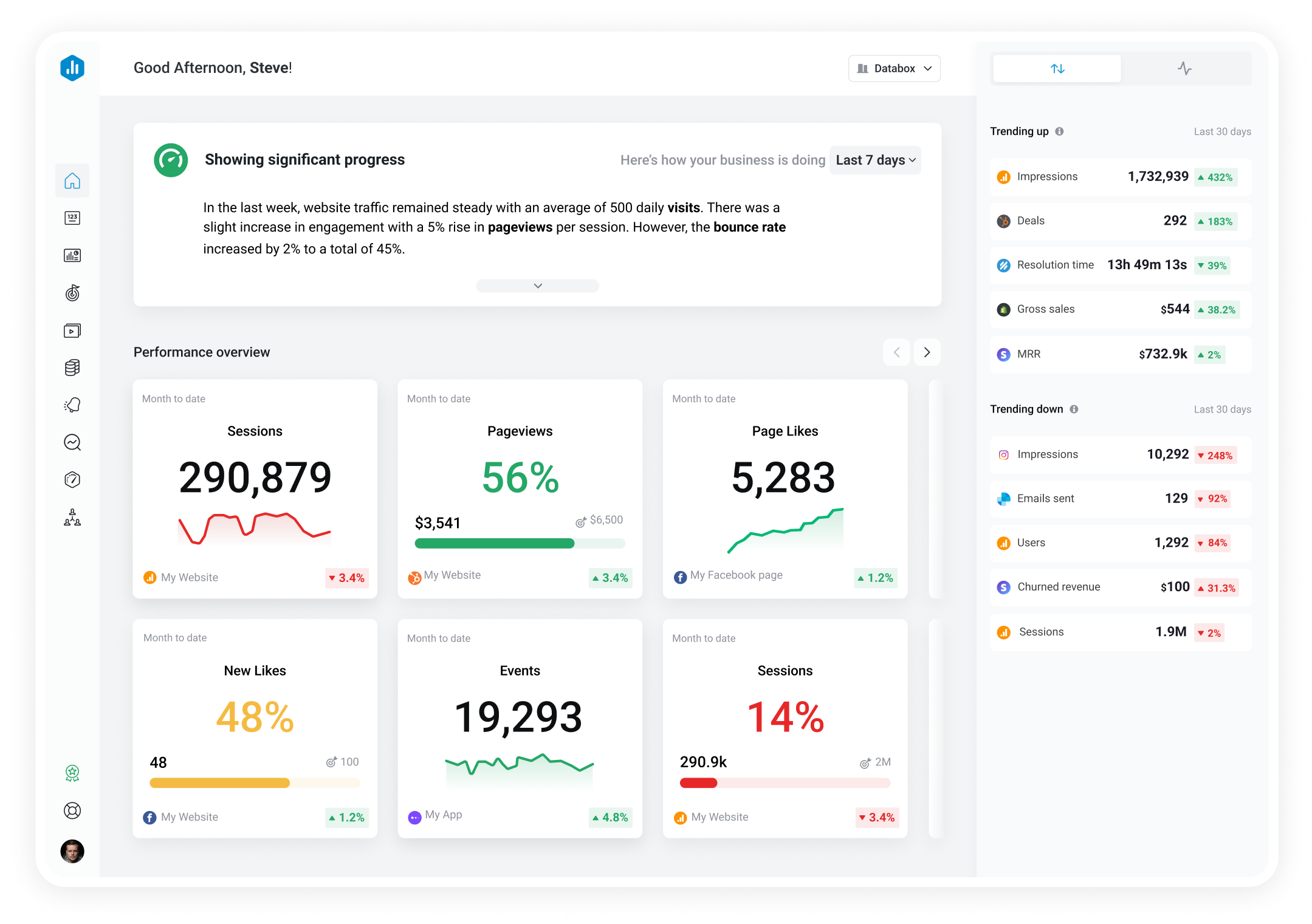Track all of your key business metrics from one screen
GET STARTED
 Google Analytics 4
Sessions
Google Analytics 4
Sessions Sessions are a collection of interactions that take place on a website within a specified time frame. Each session can include multiple pageviews, events, and other actions taken by a user.
With Databox you can track all your metrics from various data sources in one place.
Sessions refer to a Google Analytics 4 metric that measures the number of individual sessions in which a user interacts with your website or app. It indicates how many times users engaged with your content within a set period, such as a day, week, or month, which is essential for understanding user engagement and how effective your website or app is at retaining users.
Each session includes a group of interactions within a specified time frame, such as pageviews, events, or transactions. A session starts when a user initiates their first interaction, such as visiting a webpage, and ends when there is no further activity for a specified duration or when the user leaves the platform.
Sessions are automatically calculated by web analytics tools using session tracking mechanisms like cookies. When a user visits a website, a unique session identifier is assigned to track their interactions until the session ends.
What constitutes a “good” number of sessions depends on factors such as website size, target audience, and business objectives. A higher number of sessions may indicate a more engaged audience and increased potential for conversions.
It’s essential to compare session metrics over time and against industry benchmarks for meaningful insights. Databox Benchmark Groups allow you to access these benchmarks and see where you stand in comparison with your peers.
For example, according to our group Google Analytics Benchmarks for All Companies, a good number of sessions is at least 5,000 a month. For HubSpot Benchmarks (Marketing and Sales) for All Companies, the benchmark number is the same.
Join our Benchmark Group to learn more—it’s anonymous and free for everyone!
Increasing the number of sessions can boost website visibility, user engagement, and potential conversions. You may also want to work on improving session duration and the number of pages per session. Here are effective strategies to achieve this:
More resources to help you improve:

Used to show a simple Metric or to draw attention to one key number.

Used to illustrate numerical proportions through the size of the slices.

Used to show comparisons between values.
Databox is a business analytics software that allows you to track and visualize your most important metrics from any data source in one centralized platform.
To track Sessions using Databox, follow these steps:
 Goals
Goals Scorecards
Scorecards Metric Digest
Metric Digest Metric Builder
Metric Builder Data Calculations
Data Calculations Performance Screen
Performance ScreenThis E-commerce Customer Overview dashboard includes WooCommerce and Google Analytics 4 to provide key insights into customer sales performance and audience trends. It includes customer traffic metrics and sales metrics.


This template moves you through the Attract stage by showing your social media follows and reach, blog view performance, and overall visibility trends.







This dashboard gives an overview of user acquisition and behavior on your website based on Google Analytics data.


Use this Google Analytics 4 report to analyze and share insights into website engagement, audience behavior, and content marketing efforts.

Use this GA4 advanced report to share high-level and in-depth metrics of your website performance. Present key insights like Sessions, Pageviews, Audience Behavior, and more.

Measuring sessions helps businesses understand user behavior, engagement, and website performance. It helps businesses understand which pages or content are most popular, how users navigate the site, and what actions they take during their visit, enabling data-driven decisions for improvements.
Session duration measures the average time users spend on the website during a session. Longer session durations generally indicate higher user engagement and interest in the content.
A good number of sessions per user can vary based on the website’s purpose and industry. For example, for e-commerce websites, a good number of sessions per user can range from 2 to 5 or more, with a single user visiting the site 2 to 5 times or more within a specific period. For social media platforms, the number of sessions per user can be significantly higher, with users visiting the platform multiple times per day because social media engagement relies heavily on user interaction and content consumption.
